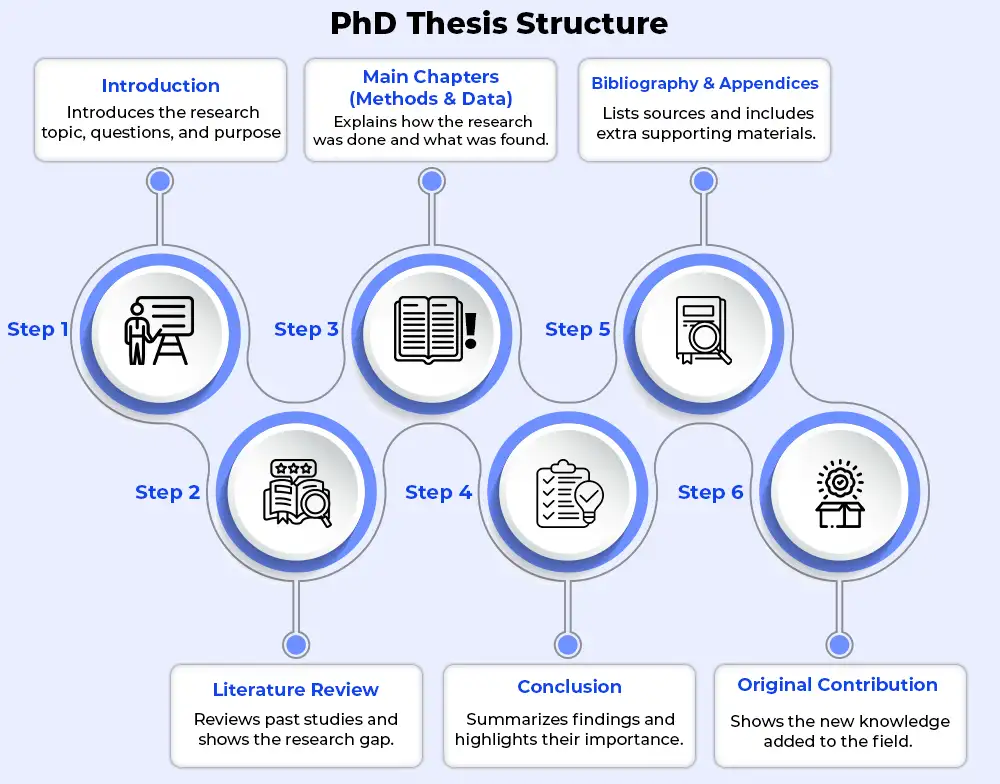Expert Interviews
- University Reviews
- Career Guide
 Video Counseling
Video CounselingImportant Facts
- Ask any Question - CV Forum

How to Write a PhD Thesis – Step-by-Step Guide for Scholars
Kopal Srivastava Jun 25, 2025 1.1K Reads

A PhD thesis is a long research report that every PhD student must write to complete their degree. It explains the research you did during your PhD and what you found. The thesis is the most important part of a PhD. It is the result of three to four years of hard work. In it, you must show that you have done new and original research in your subject.
Writing a PhD thesis can feel difficult. It has a large word count; you must write something new, and in the end, you will have to defend it in an exam called a viva. This page gives you a simple guide to help you understand what a PhD thesis is. It also includes tips on how to plan it, get feedback, and submit it.
If you're planning to write a PhD thesis, you're likely focused on deep academic research. But for business professionals who want to combine advanced research with practical business impact, an Online DBA can be a smart and flexible alternative.
Starting Your PhD Thesis
The first step in writing your PhD thesis is usually the literature review.
This is where you:
- Show that you understand what others have already written about your research topic.
- Look at books, articles, data, and other work done before you.
- Don't just repeat what others have said — you must also analyse their ideas and give your thoughts.
The literature review is often the first chapter of your PhD thesis.
You may come back later to update it if you find new information during your research.
In a PhD thesis, the focus is often on developing and testing theories. In contrast, an Online DBA thesis or final research project applies theories to real business problems. This makes it a great option for senior professionals looking to lead change in their organizations. It is also a doctoral program equivalent to a PhD Program, after pursuing it, you get recgnosed with the “Dr” title.
Doing Research for Your PhD Thesis
What makes a PhD different from other degrees is that your thesis must include something new.
You must add something original to your subject area. How you do this depends on what subject you are studying:
- Arts and Humanities: You might look at different texts, historical sources, or theories.
- Social Sciences: You might do interviews, surveys, or case studies.
- Science and Engineering (STEM): You might do lab experiments and study the results.
Some students write their thesis as they go. Others wait until the end of their research (usually the third year) to write it all.
No matter which way you choose, it’s very important to keep clear notes of everything—your data, your sources, and how you did your research.
This will help a lot when you start writing and adding references.
Thesis vs Dissertation: What’s the Difference?
People often use the words “thesis” and “dissertation” to mean the same thing, but they are a bit different:
- Your thesis is your main idea or argument — it’s the result you’ve reached after studying what others have written (literature review) and doing your own research.
- Your dissertation is the written document that explains your research and shows how you reached your thesis.
You submit your dissertation, but it is your thesis (your main idea) that your PhD is based on.That’s also why you usually write the dissertation after you’ve figured out your thesis — because you can’t explain something if you don’t know what you want to say! Still, many universities use both words to talk about PhD research. So don’t worry if you hear people using them interchangeably — they often mean the same thing in practice.
What is a Dissertation?
A dissertation is like a “final exam” in writing. Students write it to finish certain college or university degrees. Each country and university may have different rules, but usually, a student writes the dissertation with help from a guide (called an adviser). Then, experts read it to decide if it is good enough for the degree. Students may also have to talk about their work in front of a panel — this is called a dissertation defense.
The word “dissertation” is often used in place of “thesis,” but the meaning can change depending on the country:
- In the United States, a dissertation is for a PhD (doctorate), and a thesis is for bachelor’s or master’s degrees.
- In the UK and Ireland, it’s the opposite — a dissertation is for undergraduate degrees, and a thesis is for a PhD.
Dissertations can be of two types:
- Empirical (quantitative): Common in science subjects. You collect new data and explain how you did it.
- Nonempirical (qualitative): Used in other subjects. You use existing data but give your own new ideas and analysis.
A dissertation is much more detailed than a normal school paper. It includes many parts, like:
- A review of past research (literature review)
- Research methods (methodology)
- Extra documents at the end (appendices)
How long is a dissertation?
The length of a dissertation depends on the degree, subject, university, and country. But here’s a rough idea:
- Bachelor’s degree: 10,000–15,000 words (about 35–50 pages)
- Master’s degree: 18,000–22,000 words (about 65–80 pages)
- PhD or Doctorate: 80,000–100,000 words (about 200–300 pages)
PhD dissertations are very long, almost like writing a book. But these numbers can change. For example, science and tech subjects often have shorter dissertations than arts or social science subjects.
What is the PhD Thesis Structure?
Once you finish your literature review and complete your research, the next step in your PhD journey is writing your thesis. Your thesis is the most important part of your PhD. It shows all the work you have done and what new knowledge you have added to your subject.
The structure of a PhD thesis can be a little different depending on your subject or university, but most theses follow a similar pattern. Here’s what it usually looks like:

1. Introduction
This is the first chapter of your thesis. It tells the reader what your research is about, why it is important, and what new idea or solution you are offering. You may also give a brief summary of the chapters that follow. The goal is to set the stage and explain the purpose of your research.
2. Literature Review
This chapter explains what other researchers have already said or written about your topic. You look at their work and show how it connects to your own. This helps you explain the gap in the research and how your work is different or adds something new.
3. Main Chapters (Including Methods and Data)
These are the core parts of your thesis. Here, you explain how you did your research, what methods you used, and what results you found. Some theses include a separate methods chapter and a data chapter, especially in science or technical fields. Others focus more on building an argument or discussing ideas, which is common in the Arts and Humanities.
You may have around 4 or 5 main chapters, depending on your research. These chapters help build your main idea or answer your research question.
4. Conclusion
This is the final chapter. You bring everything together and restate what you discovered. You also remind the reader why your research matters and how it adds to the subject. Some students also talk about how their research could be used in the real world or suggest topics for future research.
5. Bibliography and Appendices
At the end of your thesis, you need to include a bibliography—a list of all the books, articles, and websites you used. If you have extra data, charts, surveys, or documents, you can add these in the appendix.
What is the Length of a PhD Thesis?
PhD theses are much longer than Bachelor’s or Master’s dissertations. Most are about 80,000 words, but your university may set a word limit between 70,000 and 100,000 words. Theses in science fields are often shorter than those in the humanities or social sciences.
It’s also important to check what counts in the word limit. Sometimes references, the bibliography, or appendices are not included. Always ask your supervisor to be sure.
Writing Your Thesis
This stage is called the “writing-up period.” It’s when you bring all your work together into one final document. Some students write their chapters step-by-step during the PhD, which is common in Arts and Humanities. Others, especially in science subjects, spend most of their time collecting data and writing everything at the end matter how you do it, the goal is to write a clear, well-organized thesis that shows your research and explains your findings.
-
Getting Feedback: Your supervisor will give you feedback on each chapter and then on the full thesis. They’ll guide you and make sure your research is on the right track. However, your supervisor is not your editor. You should check your writing for grammar and spelling before sharing it. They also won’t reduce the word count for you. That’s your job.
-
Submitting Your Thesis: Once your supervisor approves the final version, you’ll print and submit it for examination. Make sure to allow enough time—printing multiple copies of a long thesis can take time and may have issues.
-
Viva Exam and After: After you submit, you’ll have your viva voce, or oral exam, where you discuss your thesis with examiners. This usually happens within 3 months of submission.
After the viva, your examiners will give you one of the following results:
- Pass: You’re done!
- Minor corrections: Small edits; you get 3 months to fix them.
- Major corrections: Bigger changes or more research; usually 6 months to complete.
It’s normal for most PhD students to have some corrections. Very few theses fail completely.
Final Submission
Once you make all the corrections, you’ll submit the final version, often online. If you want to publish your work later, you can ask for an embargo so the public cannot see it right away. This is helpful if you plan to turn your thesis into a book or journal article.
Tips for Writing a PhD Thesis
You can check the points mentioned below to know the tips to write a PhD Thesis:

Tip 1: Set up a quiet, comfy writing space
- Writing a thesis takes months, often 6 to 12 months full time.
- Find a quiet, clean, and well‑lit space to work—ideally at home, not in a noisy lab or shared area.
- Get a comfortable chair, good lighting, coffee or your favorite drinks, and some snacks.
- Still, go to your university a few hours each week to meet your supervisor and stay connected with others.
Tip 2: Learn your university’s rules
- Read the rules about thesis deadlines, formatting, and submission rules.
- Check if you must submit a printed copy, an online copy, or both.
- Know font types, margins, headings, word limits, and reference style.
- Follow the rules closely to avoid issues.
Tip 3: Make a detailed table of contents
- Start with a clear plan: write a detailed contents page listing chapters, sections, and subsections.
- This might take a few days and several pages, but it helps.
- Break your thesis into small parts. For example, if you have 50 sections, write 200 words per section.
- Write five sections a day → 1,000 words/day → finish in about 100 days.
- Link the contents to each section to keep organized.
- Update the table as you go—it keeps your writing focused and helps you collect ideas.
Tip 4: Just write the first sentence
- Starting a chapter or section is often the hardest part.
- If you feel stuck, take a deep breath and write one sentence—no matter how messy.
- Once that first sentence is down, the rest often flows.
- You can fix errors later—just get started.
Tip 5: Make your introduction exciting and your conclusion strong
- Your introduction should hook the reader and outline your aims and hypothesis clearly (e.g., "I will study X to test Y").
- Each chapter should end with a short “Conclusions” section.
- The final chapter should:
- Summarize the key findings.
- Show how your aims were met.
- Point out the strengths and any weaknesses of your work.
- Suggest future research directions.
Tip 6: Keep your literature review focused
- Write only about what’s directly relevant to your topic.
- You can assume your reader has some basic knowledge.
- Don’t repeat everything; be critical—compare ideas, point out gaps, discuss disagreements.
- Keep notes, build tables, and use a reference manager to track papers and PDFs.
Tip 7: Write in a clear scientific style
- Use simple, short sentences.
- Avoid jargon, passive voice, superlatives (“fantastic,” “tremendous”), and “I/we.”
- Don’t overuse acronyms—spell them out first and include an acronym list.
- Use one idea per sentence, one idea per paragraph.
- Use clear links: “as shown in Chapter 3…”
- Proofread for mistakes and ask someone else to check your writing.
- Always back up your work—don’t trust only the cloud.
Tip 8: Be very careful with references
- Use the exact reference style required by your university.
- Watch small details: punctuation, capitalization, and page numbers.
- Use a reference manager—but check every entry meets style rules.
- Make sure every citation in your text is in your list and vice versa.
- Prefer recent papers, unless older ones are very important.
Tip 9: Choose a clear, accurate title
- Start with a working title, but re-check it near the end.
- Make sure the title reflects your final work accurately.
- Include keywords, keep it simple, avoid acronyms, and aim for no more than 12 words.
Tip 10: Write your abstract last
- The abstract is a summary—about 300–500 words—written at the end.
- It answers: What did you do? Why? How? What did you find? Why does it matter?
- The abstract is often what examiners read first—it needs to be strong and clear.
- It’s also used for library records and promotions—include keywords.
Some Samples of PhD Theses
You can click the link below to see some of the PhD theses:
- https://eprints.qut.edu.au/16327/1/Md._Abu_Saleh_Thesis.pdf
- https://web.stanford.edu/group/moler/theses/JWGThesis.pdf
- https://www.kmstechnologies.com/documents/PhD%20Thesis_KRISHNA%20KUMAR.pdf
- https://pure.southwales.ac.uk/files/908125/Thesis.pdf
Consider an Online DBA Instead of a Traditional PhD?
If you’re a working professional looking to gain a doctorate without stepping away from your career, an Online DBA program offers flexibility, applied learning, and career-focused research. Learn how to build your leadership edge while earning a doctorate—100% online.
A traditional PhD is great for those who want to become researchers or professors. It focuses on theory, deep academic research, and takes several years of full-time study. But if you are a working professional who wants to grow in your career, an Online Doctor of Business Administration (DBA) might be a better choice.
An Online DBA is designed for professionals who want to solve real business problems using research. It focuses more on practical learning and applying theories to real-life situations. You don’t need to leave your job to study, as most Online DBA programs are flexible and let you learn at your own pace.
PhD programs are often more academic and time-consuming. They usually require full-time commitment and may take 5–6 years or more. In contrast, most Online DBA programs can be completed in 3–4 years part-time, while you continue working.
Also, the outcome is different. A PhD helps you become an academic expert, often leading to teaching or research careers. But an Online DBA helps you become a better leader, decision-maker, and strategist in the business world. It prepares you for top roles like CEO, consultant, or business advisor.
Another big plus is that Online DBA programs often have global exposure. You get to learn from international faculty, connect with professionals worldwide, and work on real-time business projects.
In short, if your goal is to move up in your career, lead a company, or make a direct impact on business, an Online DBA is a smarter, faster, and more practical choice than a traditional PhD. It gives you a doctorate-level qualification with real-world value—without putting your career on hold. Check the table below to know the universities offering an Online DBA-
|
Universities |
Fees |
|
INR 6,00,000 |
|
|
INR 8,14,000 |
|
|
INR 8,12,500 |
|
|
INR 8,14,000 |
|
|
INR 5,50,000 |
|
|
INR 7,50,000 |
|
|
INR 7,00,000 |
Conclusion
Writing a PhD thesis is a long and challenging journey, but with careful planning, dedication, and support, it becomes manageable. From understanding your topic to writing each chapter, every step is important. Always keep your research clear, original, and well-organized. If you're a working professional, you can also consider an Online DBA program. It allows you to gain a doctoral degree while continuing your job and solving real business problems. Whether you choose a PhD or an Online DBA, both can help you reach great academic and professional heights when done with focus and passion.
FAQs (Frequently Asked Questions)
Start by making a plan. Write down what each chapter will include. Make a rough outline (called a thesis skeleton or storyboard). Choose titles for your chapters (you can change them later) and decide how many words each chapter will have.
A PhD thesis usually includes:
- Title page
- Abstract
- Acknowledgements
- Table of contents
- Introduction
- Literature review
- Research methods
- Results
- Discussion
- Conclusion
- References
- Appendices (if needed)
Use formal and academic English. Write clearly and logically. Avoid slang or emotional language. Use short paragraphs with topic sentences. Support every point with research or data.
Use the correct font (like Times New Roman, size 12). Keep margins equal on all sides. Number all pages clearly. Follow your university’s formatting rules (APA, MLA, or Chicago style, etc.).
Many people say starting a new chapter or section is the hardest part. If you feel stuck, just start writing anything – you can improve it later.
Choose a doable research topic:
- Read regularly
- Write as you research
- Follow deadlines
- Get feedback from your supervisor
- Stay focused and avoid distractions
Most PhD theses have 5 to 7 main chapters. This includes the introduction, literature review, methods, results, discussion, and conclusion. But it depends on your subject and university.
No, you should avoid informal language. A PhD thesis should sound professional and serious. Use clear, academic words and define technical terms when needed.

10 Years of Experience / Storyteller / Research-driven Writer
Loves to create story and narrating them through a Podcast
Every query is essential.
Our team of experts, or experienced individuals, will answer it within 24 hours.
Recommended for you
Tired of dealing with call centers!
Get a professional advisor for Career!
LIFETIME FREE
Rs.1499(Exclusive offer for today)

Pooja
MBA 7 yrs exp

Sarthak
M.Com 4 yrs exp

Kapil Gupta
MCA 5 yrs exp
or



Career Finder
(Career Suitability Test)
Explore and Find out your Most Suitable Career Path. Get Started with our Career Finder Tool Now!
ROI Calculator
Find out the expected salary, costs, and ROI of your chosen online university with our free calculator.
